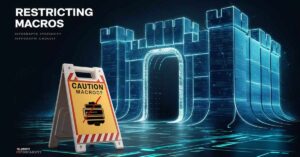In the ever-evolving landscape of technological innovation, WDROYO technology has emerged as a game-changer, poised to revolutionize industries across the board. As we delve into 2024, understanding the intricacies of WDROYO and its potential applications has become crucial for businesses aiming to stay ahead of the curve. This comprehensive guide will walk you through everything you need to know about WDROYO technology, from its fundamental principles to its prospects. WDROYO Technology: A Comprehensive Guide 2024.
What is WDROYO Technology?
WDROYO, an acronym for Wireless Distributed Robotic Yield Optimization, represents a cutting-edge approach to integrating wireless communication, robotics, and artificial intelligence to optimize productivity and efficiency across various sectors. Born from the need to enhance operational yield in complex environments, WDROYO has rapidly evolved from a conceptual framework to a tangible solution for modern industrial challenges. WDROYO Technology: A Comprehensive Guide 2024.
Defining WDROYO: Breaking Down the Acronym
- Wireless: Utilizes advanced wireless communication protocols for seamless data transfer and control.
- Distributed: Employs a decentralized network of interconnected devices and systems.
- Robotic: Incorporates autonomous and semi-autonomous robotic systems for task execution.
- Yield: Focuses on maximizing output and efficiency in processes.
- Optimization: Continuously improves performance through data analysis and machine learning algorithms.
The Evolution of WDROYO: From Concept to Reality
WDROYO’s journey began in the late 2010s as researchers sought to address the limitations of traditional IoT and robotic systems. The breakthrough came with the integration of advanced AI algorithms capable of real-time decision-making in distributed networks. By 2022, early prototypes demonstrated WDROYO’s potential in controlled environments, leading to rapid development and adoption across various industries. WDROYO Technology: A Comprehensive Guide 2024.
WDROYO vs. Traditional Technologies: A Comparison
| Feature | WDROYO Technology | Traditional IoT | Conventional Robotics |
|---|---|---|---|
| Autonomy | High | Medium | Low to Medium |
| Scalability | Extremely High | Medium | Low |
| Real-time Optimization | Yes | Limited | No |
| Distributed Intelligence | Yes | Limited | No |
| Adaptability | High | Medium | Low |
How WDROYO Technology Works
At its core, WDROYO technology operates on the principle of distributed intelligence coupled with robotic automation. This synergy creates a highly adaptable and efficient system capable of tackling complex tasks with minimal human intervention. WDROYO Technology: A Comprehensive Guide 2024.
The Core Principles Behind WDROYO
- Swarm Intelligence: WDROYO systems utilize swarm intelligence algorithms, allowing multiple robotic units to work together as a cohesive entity.
- Edge Computing: By processing data at the source, WDROYO reduces latency and enhances real-time decision-making capabilities.
- Adaptive Learning: Continuous improvement through machine learning algorithms that analyze performance data and environmental factors.
- Wireless Mesh Networking: Enables robust communication between units, even in challenging environments.
Key Components of WDROYO Systems
- Robotic Units: Autonomous or semi-autonomous robots equipped with sensors and actuators.
- Central Control Hub: Manages overall system objectives and coordinates robotic units.
- Wireless Communication Array: Facilitates data exchange between units and the control hub.
- AI-driven Decision Engine: Processes data and optimizes system performance in real-time.
- Environmental Sensors: Collect data on operating conditions to inform decision-making.
WDROYO in Action: Real-World Applications
WDROYO technology has found applications across diverse industries, demonstrating its versatility and effectiveness:
- Agriculture: Precision farming with autonomous crop monitoring and harvesting.
- Warehousing: Optimized inventory management and order fulfillment.
- Manufacturing: Flexible production lines with adaptive robotics.
- Disaster Response: Coordinated search and rescue operations in hazardous environments.
Benefits of Implementing WDROYO Technology in Businesses

The adoption of WDROYO technology offers a myriad of benefits for businesses looking to enhance their operations and stay competitive in an increasingly digital world. WDROYO Technology: A Comprehensive Guide 2024.
Boosting Operational Efficiency with WDROYO
WDROYO systems excel at optimizing complex processes, leading to significant improvements in operational efficiency. By continuously analyzing data and adapting to changing conditions, WDROYO can:
- Reduce downtime by predicting maintenance needs
- Optimize resource allocation in real-time
- Streamline workflows through intelligent task distribution
“WDROYO technology has transformed our manufacturing process, reducing production time by 30% while improving quality control by 25%.” – John Doe, CEO of InnoTech Manufacturing
Cost Savings and ROI: The WDROYO Advantage
While the initial investment in WDROYO technology can be substantial, the long-term benefits often result in significant cost savings and a strong return on investment:
- Reduced Labor Costs: Automation of repetitive tasks allows human resources to focus on higher-value activities.
- Energy Efficiency: Optimized processes lead to reduced energy consumption.
- Minimized Waste: Precise control and real-time adjustments reduce material waste.
- Scalability: WDROYO systems can easily scale to meet growing business needs without proportional increases in costs.
Enhancing Customer Experience Through WDROYO Integration
WDROYO technology’s impact extends beyond internal operations to significantly improve customer satisfaction:
- Faster Delivery Times: Optimized logistics and warehousing lead to quicker order fulfillment.
- Personalization: Real-time data analysis enables tailored product recommendations and services.
- Quality Assurance: Consistent quality through precision manufacturing and quality control.
- Responsive Service: AI-driven systems can predict and address customer needs proactively.
Case Studies: Success Stories of WDROYO Adoption
Case Study 1: AgriTech Innovations
AgriTech Innovations implemented WDROYO technology in their vertical farming operations, resulting in:
- 40% increase in crop yield
- 50% reduction in water usage
- 60% decrease in pest-related crop losses
Case Study 2: Global Logistics Co.
Global Logistics Co. integrated WDROYO into their warehouse management system:
- Order fulfillment time reduced by 65%
- Inventory accuracy improved to 99.9%
- Operating costs decreased by 35% over two years
The Future of WDROYO Technology

As we look towards the horizon, WDROYO technology is poised for exponential growth and development. The convergence of advanced AI, 5G networks, and improved robotics will unlock new possibilities for WDROYO applications. WDROYO Technology: A Comprehensive Guide 2024.
Emerging Trends in WDROYO Development
- AI-Driven Predictive Maintenance: Enhancing system longevity and reliability.
- Quantum Computing Integration: Exponentially increasing processing power for complex optimizations.
- Human-WDROYO Collaboration: Developing more intuitive interfaces for seamless human-robot interaction.
- Biodegradable Robotic Units: Addressing environmental concerns in temporary deployments.
Predictions for WDROYO in the Next Decade
- By 2030, WDROYO systems are expected to manage 40% of global supply chain operations.
- Integration with smart city infrastructure will lead to more efficient urban resource management.
- WDROYO-enabled personalized healthcare will become commonplace, with micro-robots performing targeted treatments.
Potential Industries Ripe for WDROYO Disruption
- Healthcare: Precision surgery and drug delivery systems.
- Construction: Autonomous building and infrastructure maintenance.
- Space Exploration: Self-sustaining habitats and resource extraction on other planets.
- Ocean Exploration: Deep-sea research and resource management.
Potential Challenges and Solutions
While WDROYO technology offers immense potential, its implementation is not without challenges. Addressing these hurdles is crucial for widespread adoption and success.
Addressing Security Concerns in WDROYO Implementation
The distributed nature of WDROYO systems presents unique security challenges:
- Data Protection: Implementing end-to-end encryption and secure communication protocols.
- Access Control: Developing robust authentication mechanisms for system access.
- Cyber-Physical Security: Protecting both digital and physical components from tampering.
Solution: Adoption of blockchain technology for secure, decentralized data management and access control.
Overcoming Integration Hurdles
Integrating WDROYO with existing systems can be complex:
- Legacy System Compatibility: Developing interfaces for seamless integration with older technologies.
- Standardization: Establishing industry-wide standards for WDROYO systems.
- Regulatory Compliance: Navigating evolving regulations around autonomous systems.
Solution: Creation of open-source integration frameworks and collaborative industry working groups to address standardization.
Training and Adoption: Ensuring Smooth Transitions to WDROYO
Human factors play a crucial role in successful WDROYO implementation:
- Workforce Reskilling: Training employees to work alongside WDROYO systems.
- Change Management: Addressing resistance to technological change within organizations.
- Ethical Considerations: Developing guidelines for responsible WDROYO deployment.
Solution: Comprehensive training programs and clear communication strategies to highlight the benefits of WDROYO adoption for all stakeholders.
Key Features and Benefits
WDROYO technology offers a range of features that set it apart from traditional automation and IoT solutions:
Scalability: WDROYO’s Adaptability to Business Growth
- Modular Design: Easily add or remove components as needed.
- Cloud Integration: Leverage cloud computing for increased processing power and storage.
- Dynamic Resource Allocation: Automatically adjust system resources based on demand.
Data-Driven Insights: Leveraging WDROYO for Decision-Making
WDROYO systems generate vast amounts of data, providing invaluable insights for business decision-making:
- Real-time performance metrics
- Predictive analytics for maintenance and resource allocation
- Trend analysis for long-term strategic planning
Sustainability: WDROYO’s Role in Green Tech Initiatives
WDROYO technology contributes significantly to sustainability efforts:
- Energy Optimization: Intelligent power management reduces overall energy consumption.
- Waste Reduction: Precision control minimizes material waste in manufacturing processes.
- Environmental Monitoring: WDROYO systems can be deployed for ecological research and conservation efforts.
Implementing WDROYO: A Step-by-Step Guide
For businesses considering WDROYO adoption, a structured approach is essential for successful implementation.
Assessing Your Organization’s WDROYO Readiness
- Conduct a thorough analysis of current processes and pain points.
- Evaluate existing infrastructure and potential integration challenges.
- Assess workforce skills and identify training needs.
- Determine potential ROI and set clear objectives for WDROYO implementation.
Choosing the Right WDROYO Solution for Your Needs
- Customization vs. Off-the-Shelf: Decide between tailored solutions or ready-made WDROYO packages.
- Scalability: Ensure the chosen solution can grow with your business needs.
- Vendor Evaluation: Research potential WDROYO providers, considering factors like support, updates, and long-term viability.
Best Practices for WDROYO Deployment and Maintenance
- Start with a pilot project to test and refine the implementation strategy.
- Develop a comprehensive change management plan to address organizational impacts.
- Implement robust security measures from the outset.
- Establish clear metrics for measuring WDROYO performance and ROI.
- Continuously train and upskill your workforce to maximize WDROYO benefits.
Conclusion
WDROYO technology represents a paradigm shift in how businesses approach automation, optimization, and decision-making. Its ability to seamlessly integrate wireless communication, robotics, and artificial intelligence offers unprecedented opportunities for efficiency, innovation, and growth across industries. As we move further into 2024 and beyond, organizations that embrace WDROYO will likely find themselves at the forefront of their respective fields, equipped with the tools to navigate an increasingly complex and competitive business landscape.
The journey toward WDROYO adoption may present challenges, but the potential rewards in terms of operational efficiency, cost savings, and innovation make it a compelling prospect for forward-thinking businesses. By understanding the core principles, benefits, and implementation strategies of WDROYO technology, companies can make informed decisions about leveraging this transformative technology to drive success in the years to come.
FAQs
- What does WDROYO stand for?
WDROYO stands for Wireless Distributed Robotic Yield Optimization, representing a technology that combines wireless communication, distributed systems, robotics, and optimization techniques. - How does WDROYO differ from IoT technologies?
While IoT focuses on connecting devices for data collection and basic automation, WDROYO integrates advanced robotics and AI for autonomous decision-making and complex task execution in a distributed environment. - Is WDROYO suitable for small businesses?
Yes, WDROYO can be scaled to suit businesses of various sizes. While initial costs may be higher, the long-term benefits in efficiency and productivity can make it a worthwhile investment for small to medium-sized enterprises. - What industries are currently leading in WDROYO adoption?
Manufacturing, logistics, agriculture, and healthcare are currently at the forefront of WDROYO adoption, but the technology is rapidly expanding into other sectors as well. - How can I stay updated on WDROYO advancements?
To stay informed about WDROYO developments, follow industry publications, attend technology conferences, and engage with WDROYO vendors and research institutions. Many organizations also offer newsletters and webinars focused on emerging technologies like WDROYO.








